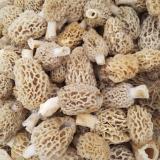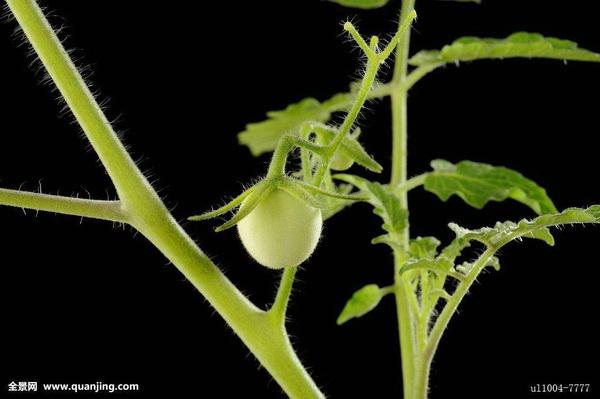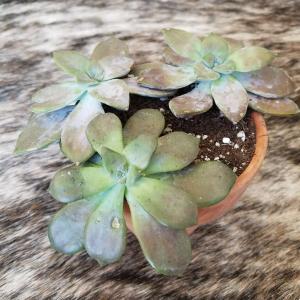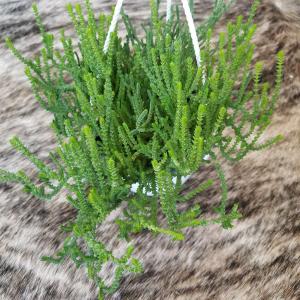成长记
Llamadrama
2017年11月23日

I now added "Gasteria baylisslama, Gasteria carinata - Keeled Ox Tongue" in my "garden"


1
0
文章
Miss Chen
2017年11月23日

The juicy, lush flavor and rampant, easy-care growth makes tomatoes (Solanum lycopersicum) a garden favorite. While humans enjoy the sweet, tart flavor of the fruits, caterpillars are also attracted to the tomato plants, requiring quick action to remove the hungry invaders. Although the tomato plants will keep producing fruits, reducing the number of caterpillars on the plants will increase the harvest. Removal methods range from hand-picking to spraying insecticides.

About Tomato Plants
Although tomatoes are grown as annuals, the South American natives are tender perennials, hardy in U.S. Department of Agriculture plant hardiness zones 10 through 11. The mature fruits range from grape to softball size and may be green, yellow, orange, red or purple. The plants are sprawling and bushy with vine-like branches. They require full sun and at least 1 inch of water per week -- and more in hot weather.
The Caterpillars
Several different types of caterpillars infest tomato plants and their fruits. You can identify the pest by its appearance and the damage it causes.
The tomato hornworm (Manduca quinquemaculata) is a large, green and white striped, smooth-skinned caterpillar with a "horn" on its tail. It has a segmented appearance accentuated by the stripes. A hornworm can defoliate entire branches overnight. Tomato hornworms grow up to 3 1/2 inches long.
The alfalfa looper (Autographa californica) and cabbage looper (Trichoplusia ni) also feed on the foliage of a variety of plants, including tomatoes. Loopers are smooth green caterpillars that crawl by bringing their back legs forward, arching their backs, similar to an inchworm. They grow up to 1 1/2 inches long.

The tomato fruitworm (Helicoverpa zea) and tobacco budworm (Heliothis virescens) are similar in appearance, with young caterpillars ranging from cream to yellow and darkening to yellow-green or brown-red as they mature. Older caterpillars have tiny, thorn-like spines and grow up to 1 inch long. Both caterpillars attack and chew on the buds, blossoms and developing tomatoes. They enter the fruit by chewing a hole in the skin and then eat the inside of the tomato.
Variegated cutworms (Peridroma saucia) and black cutworms (Agrotis ipsilon) are among the cutworm species that attack new seedlings and tomato fruits. At night, the cutworm emerges from hiding in the dirt or plant debris and chews the tender stem of the seedling. It may also chew on the fruits, especially if the tomatoes are touching the ground. Cutworms are 1 to 2 inches long and smooth skinned. They curl up when touched.
Non-Insecticide Controls
Hand pick the caterpillars. Large caterpillars, such as the tomato hornworm, are easily hand picked from the tomato plant. Put on gloves if you're squeamish about touching caterpillars. Look at the plant and let your eyes follow the branch down the ragged stubs of the devoured leaves and eventually you'll see the fat green caterpillar amid the stems and leaves. Pluck it from the tomato plant and drop it into a bucket of soapy water.
Make cardboard collars to protect the tomato stems from cutworms. A simple 2 1/2-inch tall and 8-inch long cardboard collar formed into a circle and then pressed 1 inch into the soil surrounding the plant prevents the cutworm from encircling the stem and chewing it off. Alternately, cut off the bottom of a paper or plastic cup and insert the top portion of the cup into the soil to protect the tender stem.
Cultivate the soil after the harvest. By removing dead and dying vegetation and tilling the garden after the harvest, you can destroy many of the larvae and the pupae before winter. Fewer emerging moths in spring means fewer caterpillars to munch on your tomatoes next season.
Less Toxic Insecticides
In the home garden, targeting caterpillars with less toxic insecticides allows beneficial insects, such as bees, to continue to pollinate the other fruits and vegetables. In addition, using less toxic options means you can treat your tomatoes up to the day of harvest. Before mixing and applying any insecticides, put on gloves, safety goggles and a breathing mask to avoid contact with the insecticide. Always follow the manufacturer's instructions carefully.
Bacillus thuringiensis, a bacterium, is toxic to many caterpillar species, including hornworms, fruitworms, budworms and loopers. Mix a Bt concentrate at a rate of 1 to 3 teaspoons into 1 gallon of water for hornworms and 2 to 4 teaspoons into 1 gallon of water for other caterpillars. Spray the tomato's leaves until they are covered with the solution. Repeat weekly or as needed to control caterpillars.
Ready-to-use neem oil products may be used on a seven- to 14-day schedule. Apply the solution in the early morning or late evening to avoid burning the tomato plant. Shake the spray bottle well and spray the tomato plant until the leaves are soaked by the solution.
Spinosaid concentrate is mixed at 4 tablespoons per gallon of water and applied until the tomato plant is soaking wet. It kills infestations of loopers and other caterpillars. It may be reapplied four days apart and up to six times per year.

About Tomato Plants
Although tomatoes are grown as annuals, the South American natives are tender perennials, hardy in U.S. Department of Agriculture plant hardiness zones 10 through 11. The mature fruits range from grape to softball size and may be green, yellow, orange, red or purple. The plants are sprawling and bushy with vine-like branches. They require full sun and at least 1 inch of water per week -- and more in hot weather.
The Caterpillars
Several different types of caterpillars infest tomato plants and their fruits. You can identify the pest by its appearance and the damage it causes.
The tomato hornworm (Manduca quinquemaculata) is a large, green and white striped, smooth-skinned caterpillar with a "horn" on its tail. It has a segmented appearance accentuated by the stripes. A hornworm can defoliate entire branches overnight. Tomato hornworms grow up to 3 1/2 inches long.
The alfalfa looper (Autographa californica) and cabbage looper (Trichoplusia ni) also feed on the foliage of a variety of plants, including tomatoes. Loopers are smooth green caterpillars that crawl by bringing their back legs forward, arching their backs, similar to an inchworm. They grow up to 1 1/2 inches long.

The tomato fruitworm (Helicoverpa zea) and tobacco budworm (Heliothis virescens) are similar in appearance, with young caterpillars ranging from cream to yellow and darkening to yellow-green or brown-red as they mature. Older caterpillars have tiny, thorn-like spines and grow up to 1 inch long. Both caterpillars attack and chew on the buds, blossoms and developing tomatoes. They enter the fruit by chewing a hole in the skin and then eat the inside of the tomato.
Variegated cutworms (Peridroma saucia) and black cutworms (Agrotis ipsilon) are among the cutworm species that attack new seedlings and tomato fruits. At night, the cutworm emerges from hiding in the dirt or plant debris and chews the tender stem of the seedling. It may also chew on the fruits, especially if the tomatoes are touching the ground. Cutworms are 1 to 2 inches long and smooth skinned. They curl up when touched.
Non-Insecticide Controls
Hand pick the caterpillars. Large caterpillars, such as the tomato hornworm, are easily hand picked from the tomato plant. Put on gloves if you're squeamish about touching caterpillars. Look at the plant and let your eyes follow the branch down the ragged stubs of the devoured leaves and eventually you'll see the fat green caterpillar amid the stems and leaves. Pluck it from the tomato plant and drop it into a bucket of soapy water.
Make cardboard collars to protect the tomato stems from cutworms. A simple 2 1/2-inch tall and 8-inch long cardboard collar formed into a circle and then pressed 1 inch into the soil surrounding the plant prevents the cutworm from encircling the stem and chewing it off. Alternately, cut off the bottom of a paper or plastic cup and insert the top portion of the cup into the soil to protect the tender stem.
Cultivate the soil after the harvest. By removing dead and dying vegetation and tilling the garden after the harvest, you can destroy many of the larvae and the pupae before winter. Fewer emerging moths in spring means fewer caterpillars to munch on your tomatoes next season.
Less Toxic Insecticides
In the home garden, targeting caterpillars with less toxic insecticides allows beneficial insects, such as bees, to continue to pollinate the other fruits and vegetables. In addition, using less toxic options means you can treat your tomatoes up to the day of harvest. Before mixing and applying any insecticides, put on gloves, safety goggles and a breathing mask to avoid contact with the insecticide. Always follow the manufacturer's instructions carefully.
Bacillus thuringiensis, a bacterium, is toxic to many caterpillar species, including hornworms, fruitworms, budworms and loopers. Mix a Bt concentrate at a rate of 1 to 3 teaspoons into 1 gallon of water for hornworms and 2 to 4 teaspoons into 1 gallon of water for other caterpillars. Spray the tomato's leaves until they are covered with the solution. Repeat weekly or as needed to control caterpillars.
Ready-to-use neem oil products may be used on a seven- to 14-day schedule. Apply the solution in the early morning or late evening to avoid burning the tomato plant. Shake the spray bottle well and spray the tomato plant until the leaves are soaked by the solution.
Spinosaid concentrate is mixed at 4 tablespoons per gallon of water and applied until the tomato plant is soaking wet. It kills infestations of loopers and other caterpillars. It may be reapplied four days apart and up to six times per year.
0
0
文章
Miss Chen
2017年11月23日

Tomato plants are now a staple in the home garden. Tomatoes are high in Vitamin A, Vitamin C and lycopene. Lycopene helps ward off many cancers.

Origin
Tomato plants originally come from South and Central America along the Andes Mountains. Wildlife readily dispersed tomato seeds throughout countries such as Bolivia, Chile and Peru.
Dispersion
Tomato seeds can be dispersed by birds and foraging animals. Animals excrete the undigested seeds miles away from the original plant. Half-eaten fruit was often carried and dropped miles away from the original plant.
Fact
The ovary of a flower grows, ripens and develops one or more seeds. This is how fruit form. Tomatoes are fruits.

History in America
Tomato plants bear a strong resemblance to deadly nightshade. During Colonial Times, they were imported and grown for decoration until considered to be a human food source in the mid 1830s. Birds and foraging animals ate the tomato fruit and dispersed seed throughout North America.
Culture
The dispersed seeds of tomato plants grew well in areas where there was plentiful rainfall, full sun and well-drained soil.

Origin
Tomato plants originally come from South and Central America along the Andes Mountains. Wildlife readily dispersed tomato seeds throughout countries such as Bolivia, Chile and Peru.
Dispersion
Tomato seeds can be dispersed by birds and foraging animals. Animals excrete the undigested seeds miles away from the original plant. Half-eaten fruit was often carried and dropped miles away from the original plant.
Fact
The ovary of a flower grows, ripens and develops one or more seeds. This is how fruit form. Tomatoes are fruits.

History in America
Tomato plants bear a strong resemblance to deadly nightshade. During Colonial Times, they were imported and grown for decoration until considered to be a human food source in the mid 1830s. Birds and foraging animals ate the tomato fruit and dispersed seed throughout North America.
Culture
The dispersed seeds of tomato plants grew well in areas where there was plentiful rainfall, full sun and well-drained soil.
0
0
文章
Miss Chen
2017年11月22日

You can plant more tomato plants (Lycopersicon esculentum) in a garden when you support them with stakes or wire cages than if you let them sprawl on the ground. Because tomatoes require a soil temperature of at least 60 degrees Fahrenheit to plant from seed, most gardeners transplant nursery seedlings. How far apart you space plants also depends on the type of tomato, because some varieties need more space.

Spacing and Tomato Varieties
Determinate tomato varieties eventually form a cluster of flowers at their tip and stop growing taller. They are easier to grow and control and their tomatoes ripen earlier. Indeterminate tomatoes, including nearly all older and heirloom varieties, grow larger vines with a larger, more flavorful crop of late-maturing tomatoes. Indeterminate cultivars need to be planted farther apart than determinate or dwarf cultivars. Most people treat tomatoes as annuals but they will technically grow as perennials in U.S. Department of Agriculture plant hardiness zones 9 through 11.
Spacing Staked Tomatoes
If you train your tomatoes to grow on stakes you'll get larger tomatoes and they'll ripen earlier, but you'll get fewer of them and they're more likely to suffer from sun scald. Plant staked tomatoes 2 feet apart in rows spaced 3 to 4 feet apart. Dwarf tomatoes will only need 12 inches between plants. To give yourself enough room to harvest tomatoes, space vigorous indeterminate cultivars 4 feet apart and space rows 5 to 6 feet apart.
Spacing Caged Tomatoes
Plant caged tomatoes 2 1/2 to 3 feet apart in rows separated by 4 to 5 feet. Determinate tomatoes are best suited to cages. Prune the plants so that they will have from three to five stems. Especially vigorous indeterminate tomatoes will require larger cages, fewer stems in each cage and more space between plants and rows.

Spacing Tomatoes in Intensive Gardens
Plants in intensive gardens are spaced so their centers are an equal distance from one another. Tomatoes are especially suited to intensive gardening because they can be trained to grow vertically on stakes, cages or trellises. Space tomatoes 12 to 18 inches apart in an intensive garden.

Spacing and Tomato Varieties
Determinate tomato varieties eventually form a cluster of flowers at their tip and stop growing taller. They are easier to grow and control and their tomatoes ripen earlier. Indeterminate tomatoes, including nearly all older and heirloom varieties, grow larger vines with a larger, more flavorful crop of late-maturing tomatoes. Indeterminate cultivars need to be planted farther apart than determinate or dwarf cultivars. Most people treat tomatoes as annuals but they will technically grow as perennials in U.S. Department of Agriculture plant hardiness zones 9 through 11.
Spacing Staked Tomatoes
If you train your tomatoes to grow on stakes you'll get larger tomatoes and they'll ripen earlier, but you'll get fewer of them and they're more likely to suffer from sun scald. Plant staked tomatoes 2 feet apart in rows spaced 3 to 4 feet apart. Dwarf tomatoes will only need 12 inches between plants. To give yourself enough room to harvest tomatoes, space vigorous indeterminate cultivars 4 feet apart and space rows 5 to 6 feet apart.
Spacing Caged Tomatoes
Plant caged tomatoes 2 1/2 to 3 feet apart in rows separated by 4 to 5 feet. Determinate tomatoes are best suited to cages. Prune the plants so that they will have from three to five stems. Especially vigorous indeterminate tomatoes will require larger cages, fewer stems in each cage and more space between plants and rows.

Spacing Tomatoes in Intensive Gardens
Plants in intensive gardens are spaced so their centers are an equal distance from one another. Tomatoes are especially suited to intensive gardening because they can be trained to grow vertically on stakes, cages or trellises. Space tomatoes 12 to 18 inches apart in an intensive garden.
0
0
文章
Miss Chen
2017年11月22日

Tomatoes from your own plant taste so much better than anything you purchase at a grocery store. You do not need to have a garden, or even a plot of land, to grow a tomato plant. You can even grow tomatoes on your screened porch.

Growing Tomatoes in Containers
Growing tomato plants in containers that have drainage holes is often better than growing them in the ground. That is because you can make sure of the quality of the soil, the level of watering required and can monitor and eliminate pests.
Screened porches can be an ideal location for your tomato plants, particularly if you live in a region that gets intense heat during the summer, which tomatoes do not tolerate well. One of the most important considerations when contemplating growing your tomatoes on a screened porch is the amount and quality of sunlight the area receives. Tomatoes need at least six hours of sun per day. If your screened porch is on the shady side of your home or has wide, overhanging eaves that prevent sunlight from entering any part of your porch, your tomato plants will not flourish. The opposite is also true if your screened in porch receives too much hot, intense sunlight, such as at midday. Your tomatoes may wilt or become sunburned. In this case, you may need to partially shade your porch where your tomato plants will grow.
Another consideration deals with pollination so your plant will produce tomatoes. Tomato plants do not need bees and such to pollinate; each plant has both male and female flowers. But the plant does require that there is at least slight breezes or air movement to allow the pollen to travel from one flower to the other. If you are lacking in breezes, you can always gently shake your plants every day or so to simulate this.

Selecting the right variety of tomato can help in growing tomatoes successfully on your screened porch. The preferred type is called a patio tomato because they have been formulated to grow in containers and produce an abundance of fruit. But other varieties can also successfully be grown on your porch. From cherry tomatoes to the beefsteak variety, many types can be grown in containers. Visit your local garden center, describe your location, particularly the light, and what you want to use the tomatoes for, to a salesperson and let her assist you in selecting the right plants.

Growing Tomatoes in Containers
Growing tomato plants in containers that have drainage holes is often better than growing them in the ground. That is because you can make sure of the quality of the soil, the level of watering required and can monitor and eliminate pests.
Screened porches can be an ideal location for your tomato plants, particularly if you live in a region that gets intense heat during the summer, which tomatoes do not tolerate well. One of the most important considerations when contemplating growing your tomatoes on a screened porch is the amount and quality of sunlight the area receives. Tomatoes need at least six hours of sun per day. If your screened porch is on the shady side of your home or has wide, overhanging eaves that prevent sunlight from entering any part of your porch, your tomato plants will not flourish. The opposite is also true if your screened in porch receives too much hot, intense sunlight, such as at midday. Your tomatoes may wilt or become sunburned. In this case, you may need to partially shade your porch where your tomato plants will grow.
Another consideration deals with pollination so your plant will produce tomatoes. Tomato plants do not need bees and such to pollinate; each plant has both male and female flowers. But the plant does require that there is at least slight breezes or air movement to allow the pollen to travel from one flower to the other. If you are lacking in breezes, you can always gently shake your plants every day or so to simulate this.

Selecting the right variety of tomato can help in growing tomatoes successfully on your screened porch. The preferred type is called a patio tomato because they have been formulated to grow in containers and produce an abundance of fruit. But other varieties can also successfully be grown on your porch. From cherry tomatoes to the beefsteak variety, many types can be grown in containers. Visit your local garden center, describe your location, particularly the light, and what you want to use the tomatoes for, to a salesperson and let her assist you in selecting the right plants.
0
0
文章
Miss Chen
2017年11月22日

Biting into a sweet, succulent cherry tomato is one of the joys of summer, and somehow it tastes even better when you grew it yourself. Cherry tomatoes are not difficult to grow in a home garden, but just because cherry tomatoes are petite doesn't mean the plants are; like many tomato cultivars, some cherry tomato plants have a tendency to sprawl, and there are many good reasons to tidy them up. With some basic pruning techniques, you can trim back your cherry tomato plants fairly quickly, and get back to enjoying your summer salad.

Types to Prune
Tomato plants fall into one of two types: determinate and indeterminate. They are determinate if they form a terminal, or top, flower cluster, which is what causes them to stop growing in height. Because they grow to a fixed size and produce a fixed number of cherry tomatoes, determinates should not be pruned, although you should remove the shoots below the first flower cluster. Plants with lateral flower clusters, and no terminal, are indeterminates; their fruit ripens more slowly, and they will keep growing until killed by frost. These are the type of cherry tomato plants which should be pruned. Indeterminate cherry tomato cultivars include Super Sweets, Sweet Million, Large Red Cherry and Yellow Pear; determinate varieties include Tiny Tim and Mountain Belle.
Benefits of Pruning
Prune your indeterminates to maximize the efficiency of photosynthesis and minimize disease. In the process of vigorous growing, they send out "suckers", or shoots, that come from the main stem and can turn into main stems themselves, which send out more shoots. Although this makes the plant produce more fruit, the benefit is outweighed when the main stem can no longer bear the weight and the plant sprawls on the ground. This is not only unsightly but destructive; as fruit falls in the dirt, it is exposed to damage from insects and viruses. On the other hand, a pruned and supported single-stem tomato plant has all its fruit in the air, its leaves exposed to the sun, and flavor-enhancing sugar going to the developing fruit, since the plant is only growing at the tip. The cherry tomatoes will be larger and tastier, and will form more quickly. In addition, the leaves dry off faster when it the plant is pruned and supported, reducing the risk of bacterial and fungal infections.

Pruning Techniques
Prune the cherry tomato plant to one or—at most—two main stems, and remove lower branches to deter splashback reinfection of pathogens left in the dirt from previous years. Pinch the new suckers soon after they appear. The best way to do this is with your fingers, twisting the sucker until it snaps off; this results in a more desirable break from the stem than would occur with the use of scissors. If you've let suckers grow too long and they are hard to snap off manually, use a retractable knife. Avoid sun scald by leaving enough leaves to cover and protect the tomatoes, and prevent fungal infection by never pruning a wet tomato plant. Keep cherry tomatoes free of side stems below the first fruit cluster.

Types to Prune
Tomato plants fall into one of two types: determinate and indeterminate. They are determinate if they form a terminal, or top, flower cluster, which is what causes them to stop growing in height. Because they grow to a fixed size and produce a fixed number of cherry tomatoes, determinates should not be pruned, although you should remove the shoots below the first flower cluster. Plants with lateral flower clusters, and no terminal, are indeterminates; their fruit ripens more slowly, and they will keep growing until killed by frost. These are the type of cherry tomato plants which should be pruned. Indeterminate cherry tomato cultivars include Super Sweets, Sweet Million, Large Red Cherry and Yellow Pear; determinate varieties include Tiny Tim and Mountain Belle.
Benefits of Pruning
Prune your indeterminates to maximize the efficiency of photosynthesis and minimize disease. In the process of vigorous growing, they send out "suckers", or shoots, that come from the main stem and can turn into main stems themselves, which send out more shoots. Although this makes the plant produce more fruit, the benefit is outweighed when the main stem can no longer bear the weight and the plant sprawls on the ground. This is not only unsightly but destructive; as fruit falls in the dirt, it is exposed to damage from insects and viruses. On the other hand, a pruned and supported single-stem tomato plant has all its fruit in the air, its leaves exposed to the sun, and flavor-enhancing sugar going to the developing fruit, since the plant is only growing at the tip. The cherry tomatoes will be larger and tastier, and will form more quickly. In addition, the leaves dry off faster when it the plant is pruned and supported, reducing the risk of bacterial and fungal infections.

Pruning Techniques
Prune the cherry tomato plant to one or—at most—two main stems, and remove lower branches to deter splashback reinfection of pathogens left in the dirt from previous years. Pinch the new suckers soon after they appear. The best way to do this is with your fingers, twisting the sucker until it snaps off; this results in a more desirable break from the stem than would occur with the use of scissors. If you've let suckers grow too long and they are hard to snap off manually, use a retractable knife. Avoid sun scald by leaving enough leaves to cover and protect the tomatoes, and prevent fungal infection by never pruning a wet tomato plant. Keep cherry tomatoes free of side stems below the first fruit cluster.
0
0


















